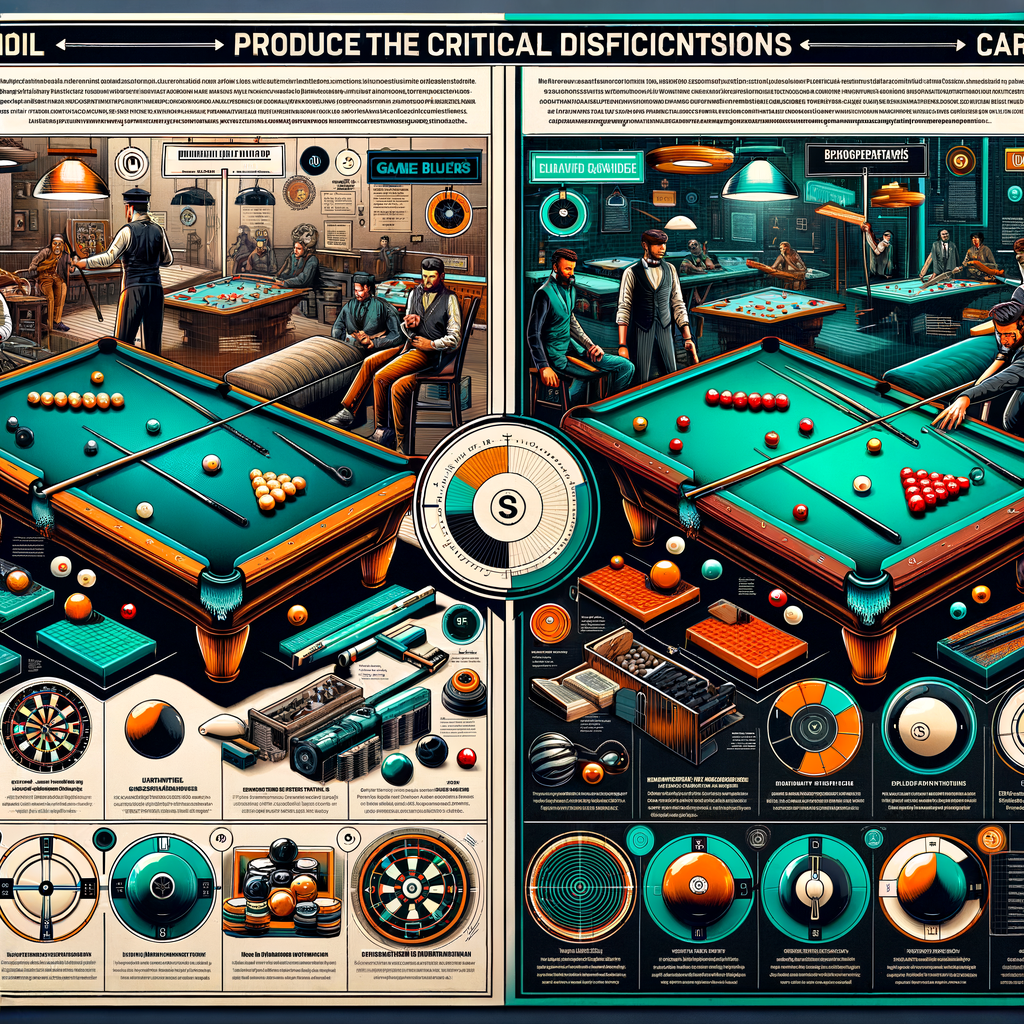
Introduction: Billiard vs Carom Comparison
Welcome to our comprehensive comparison of two fascinating games: Billiard and Carom. In this blog post, we will explore the origins, differences, strategies, and popularity of these two games. Whether you’re a seasoned player or a beginner, this guide will provide you with a wealth of knowledge.
- Overview of Billiard and Carom
Billiard and Carom are both cue sports, meaning they are played with a cue stick and balls on a table. But they have distinct rules and gameplay.
Billiard, also known as pool, is a game where players use a cue stick to hit billiard balls into one of several pockets around the pool table. The game has many variations, including eight-ball, nine-ball, and straight pool, each with its unique set of rules.
On the other hand, Carom, also known as three-cushion billiards, is a game where players aim to hit their cue ball so that it touches the other two balls on the table. Unlike billiards, Carom doesn’t have any pockets on the table. The game is all about precision and angles.
- Popularity and Prevalence of Both Games
Both Billiard and Carom have a significant following worldwide, but their popularity varies by region.
Billiard is immensely popular in the United States, the United Kingdom, and many other countries. It’s often seen in bars, pool halls, and even in homes. According to the Billiard Congress of America, there are approximately 46 million people who play pool regularly in the United States alone.
Carom, while less known in the United States, enjoys immense popularity in Europe and Asia. The Union Mondiale de Billard reports that there are over 10 million regular Carom players worldwide. The game is particularly popular in countries like Belgium, France, and South Korea.
Both games have professional leagues and tournaments, attracting players and spectators from all over the world. They require skill, strategy, and precision, making them both challenging and enjoyable to play.
History of Billiard and Carom
Origin of Billiard
-
- Early history and development
The game of billiards, also known as pool, has a rich and fascinating history. It is believed to have originated in the 15th century in France. Initially, it was an outdoor lawn game similar to croquet. Over time, it was moved indoors and played on a table with green cloth to mimic grass. The word “billiard” is derived from the French word “billart,” meaning wooden stick, and “bille,” meaning ball.
- Early history and development
- Evolution of the game
The game of billiards has evolved significantly over the centuries. In the 18th and 19th centuries, it became a popular pastime among the nobility in Europe. The game was introduced to America in the early 19th century and quickly gained popularity. The first standardized rules for billiards were established in 1850. The game continued to evolve with the introduction of new equipment and techniques. Today, billiards is played in various forms worldwide, including eight-ball, nine-ball, and snooker.
| Key Dates in Billiard History | |
|---|---|
| 15th Century | Originated in France as an outdoor lawn game |
| 18th-19th Century | Became a popular pastime among the European nobility |
| Early 19th Century | Introduced to America |
| 1850 | First standardized rules established |
Origin of Carom
Carom, also known as carom billiards, is a fascinating game with a rich history. Let’s delve into its origins and how it has evolved over time.
-
- Early history and development
The game of carom traces its roots back to the 18th century in Europe. It was initially played on a table without pockets, and the goal was to strike the opponent’s ball using a cue ball. The name ‘carom’ comes from the French word ‘carambole’, which means ‘red fruit’. This was a reference to the red ball used in the game.
Carom was a popular pastime among the European upper class. It was considered a game of skill and strategy, and was often played in social gatherings. The game was played on a large, rectangular table, usually made of wood. The players used long, thin sticks called cues to strike the balls.
-
- Evolution of the game
Over the years, carom has evolved significantly. In the 19th century, the game saw the introduction of new techniques and strategies. Players started using spin, or ‘english’, to control the cue ball’s movement. This added a new layer of complexity to the game, making it even more challenging and exciting.
In the 20th century, carom became a professional sport, with tournaments held worldwide. The game’s rules were standardized, and different variations of the game, such as three-cushion carom and straight rail, were developed. Today, carom continues to be a popular game, enjoyed by people of all ages.
In conclusion, the game of carom has a rich and varied history. From its early beginnings in Europe to its evolution into a professional sport, carom has remained a beloved game for centuries. Whether you’re a seasoned player or a beginner, there’s always something new to learn and appreciate about this fascinating game.
Differences between Billiard and Carom
Billiard and Carom are two popular cue sports that are loved by many. While they may seem similar at first glance, they have distinct rules that set them apart. Let’s delve into the game rules of both sports.
Billiard vs Carom: Game Rules
- Billiard Game Rules:Billiards, also known as pocket billiards, is played on a table with six pockets. The game involves 16 balls: one white cue ball, seven striped balls, seven solid-colored balls, and one black 8-ball. The main goal is to pocket your assigned group of balls (either stripes or solids) and then pocket the 8-ball before your opponent does. Failing to hit your own group of balls or pocketing the cue ball results in a foul.
- Carom Game Rules:Carom, or carom billiards, is played on a pocketless table with three balls: two white balls and one red ball. One of the white balls is marked with a dot to differentiate it from the other. The objective is to strike your opponent’s ball and the red ball in a single shot. The player who first reaches a set number of points, typically 50, wins the game. Unlike billiards, carom doesn’t involve pocketing balls.
As you can see, the rules of Billiard and Carom are quite different. While Billiard involves pocketing balls, Carom is all about caroming your cue ball off other balls. Both games require strategic thinking and precision, but they offer unique challenges and experiences.
Billiard vs Carom: Techniques
Both Billiard and Carom games have unique techniques that players use to gain an edge over their opponents. Let’s explore these techniques in detail.
- Billiard Techniques
Billiard is a game that requires precision and strategy. Here are some of the most common techniques used by billiard players:
- Stance: A proper stance is crucial in billiards. Players need to position their bodies in a way that allows them to aim and strike the ball accurately. This usually involves aligning the body with the shot direction and maintaining a stable and comfortable position.
- Bridge: This is the hand position that supports the cue stick. There are several types of bridges that players can use, such as the open bridge, closed bridge, and rail bridge. Each type has its own advantages and is used in different situations.
- Stroke: This refers to the movement of the cue stick when hitting the ball. A good stroke is smooth and straight, allowing the player to control the speed and direction of the ball effectively.
- English: Also known as side spin, English is a technique where the player strikes the cue ball off-center to influence its path after hitting the target ball. This technique is often used to position the cue ball for the next shot.
- Carom Techniques
Carom, on the other hand, is a game that focuses more on angles and caroms. Here are some techniques that carom players often use:
- Three-Cushion Shot: This is a common technique in carom where the player aims to hit the cue ball so it touches at least three cushions before hitting the other two balls. This requires a good understanding of angles and ball speed.
- Bank Shot: In this technique, the player hits the cue ball onto a cushion first before it hits the target balls. This is often used when the target balls are in difficult positions.
- Draw Shot: This is a technique where the player strikes the cue ball below center, causing it to spin backward after hitting the target ball. This is useful for controlling the position of the cue ball.
- Follow Shot: The opposite of a draw shot, a follow shot involves hitting the cue ball above center, causing it to continue moving in the same direction after hitting the target ball. This is also used for cue ball control.
Whether you’re playing billiards or carom, mastering these techniques can greatly improve your game. Remember, practice makes perfect, so don’t be discouraged if you don’t get it right the first time. Keep practicing and you’ll see improvement over time.
Billiard vs Carom: Equipment
Understanding the equipment used in both billiard and carom games is crucial to fully appreciate the differences and similarities between the two. Let’s dive into the specifics of each game’s equipment.
- Billiard Equipment
Billiard games primarily require a billiard table, billiard balls, and a cue stick. The standard billiard table is twice as long as it is wide, typically measuring 9 feet by 4.5 feet. The table is covered with a smooth cloth, usually green, to allow the balls to roll smoothly. The table has six pockets, one at each corner and one in the middle of each long side.
The balls used in billiards are usually made of phenolic resin and come in various colors. Each ball is numbered from 1 to 15 and divided into two groups: solid and striped. The cue stick, used to strike the balls, is typically made of wood, but it can also be made of fiberglass or carbon fiber.
- Carom Equipment
Carom games, on the other hand, are played on a pocketless table that is also covered with a smooth cloth. The table is usually slightly larger than a billiard table, measuring 10 feet by 5 feet. The game uses three balls: two white ones and one red. One of the white balls is marked with a dot to distinguish it from the other.
The cue stick used in carom is similar to the one used in billiards. However, carom cues are often heavier and have a thicker tip to handle the larger and heavier carom balls.
In conclusion, while both games use similar equipment, there are key differences that affect the gameplay and strategies of billiards and carom. Understanding these differences can help players adapt their techniques and improve their performance in each game.
Billiard vs Carom: Game Styles
Both billiards and carom have unique game styles that set them apart. Let’s delve into the specific styles of each game.
- Billiard Game StylesBilliards, also known as pool, is typically played with 15 colored balls and a white cue ball. The game style can vary depending on the specific type of billiards being played. Here are a few common styles:
- Eight-Ball: This is the most common style of billiards. The goal is to pocket all of your designated balls (either stripes or solids) and then sink the eight ball before your opponent.
- Nine-Ball: In this style, players must strike the lowest numbered ball on the table first, but any ball can be pocketed.
- Snooker: This is a more complex style of billiards played with 21 colored balls and a white cue ball. The goal is to score more points than your opponent by potting balls in a specific order.
- Carom Game StylesCarom, or carom billiards, is a type of cue sport that involves hitting a cue ball so that it contacts the opponent’s cue ball and the object ball in the same shot. Here are a few common styles:
- Three-Cushion Billiards: In this style, the cue ball must hit at least three cushions before contacting the other two balls.
- Straight Rail: This is a simpler style where the cue ball must hit the other two balls in any order.
- Balkline: This is a more complex style where certain areas of the table are sectioned off into “balk spaces”. The cue ball must exit and re-enter these spaces a certain number of times.
Billiard Game Strategies
Mastering the game of billiards requires not only skill but also strategic thinking. Here, we will discuss some key strategies for winning at billiards and look at case studies of successful billiard players who have used these strategies to their advantage.
-
- Key Strategies for Winning at Billiard
There are several strategies that can help you improve your billiard game:
-
-
- Plan Ahead: Always think a few shots ahead. This will allow you to position the cue ball for your next shot.
- Control the Cue Ball: Good control of the cue ball can help you dictate the game. Practice different spins and speeds to improve your control.
- Practice: As with any game, practice is key. The more you play, the better you will become.
- Case Studies of Successful Billiard Players
-
Let’s look at some successful billiard players and the strategies they used to win:
-
- Willie Mosconi: Known as “Mr. Pocket Billiards,” Mosconi was famous for his precision and strategic play. He always planned his shots in advance and had exceptional control of the cue ball.
- Steve Davis: A six-time World Champion, Davis was known for his meticulous preparation and practice. He spent hours practicing every day, honing his skills and perfecting his strategy.
By studying these strategies and case studies, you can improve your own billiard game. Remember, the key to success in billiards is a combination of skill, strategy, and practice.
Carom Game Strategies
Carom, a popular indoor game, is not just about striking the coins on the board. It requires strategic planning and a keen understanding of the game’s rules. In this section, we will delve into some key strategies that can help you win at Carom and also look at some case studies of successful Carom players.
- Key strategies for winning at Carom
Here are some strategies that can help you improve your Carom game:
- Practice the Basics: Mastering the basic shots is crucial. Spend time practicing your striking skills, aiming, and positioning.
- Plan your Moves: Don’t just focus on the current shot. Think ahead and plan your next few moves. This will help you control the game.
- Control the Striker: The striker is your main tool in Carom. Learn to control its speed and direction to make effective shots.
- Understand the Rules: Knowing the rules inside out will help you make better decisions during the game.
- Case studies of successful Carom players
Let’s take a look at some successful Carom players and their strategies:
| Name | Strategy |
|---|---|
| Player 1 | Player 1 focuses on mastering the basics and spends a significant amount of time practicing different shots. |
| Player 2 | Player 2 is known for his strategic planning. He always thinks a few moves ahead and uses this strategy to control the game. |
| Player 3 | Player 3 has excellent control over the striker. He can adjust the speed and direction of the striker to make effective shots. |
By studying these strategies and incorporating them into your game, you can improve your Carom skills and increase your chances of winning. Remember, practice is key to mastering any game, and Carom is no exception.
Conclusion: Choosing Between Billiard and Carom
After a detailed comparison of billiard and carom, it’s time to make a decision. Which game is right for you? The choice depends on various factors. Let’s explore them.
- Factors to Consider When Choosing Between the Two Games
Firstly, consider your personal preferences. Do you prefer a game that’s more strategic and requires careful planning, like billiards? Or do you enjoy a game that’s more about precision and control, like carom?
Secondly, think about the resources you have available. Billiard games typically require more equipment, including a larger table and more balls. On the other hand, carom can be played with fewer resources.
Lastly, consider the social aspect. Billiards is often played in teams and can be a great way to socialize. Carom, however, is usually a two-player game and can be a great way to challenge yourself.
- Final Thoughts and Key Takeaways
In conclusion, both billiard and carom offer unique experiences and challenges. Billiards is a game of strategy and team play, while carom focuses on precision and control. The choice between the two ultimately depends on your personal preferences, resources, and social needs.
Remember, the most important thing is to enjoy the game. Whether you choose billiards or carom, both games offer an opportunity to have fun, challenge yourself, and spend quality time with friends or family.
So, pick up a cue, aim for the balls, and let the games begin!














